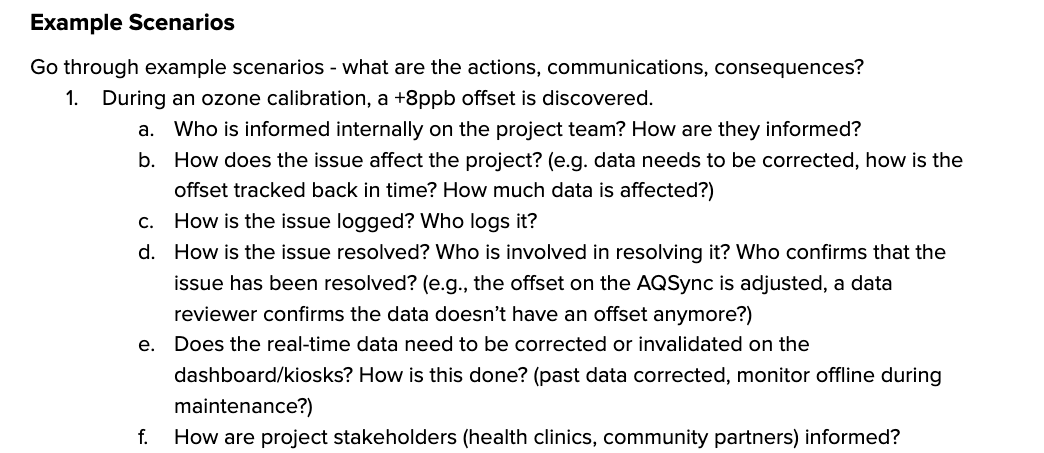Quality Assurance Project Plans - The burden and the benefit.
Why QAPPs are crucial to your air monitoring project and tips for the creation process.
Quality Assurance Project Plans, or QAPPS, are documents that describe your air monitoring project in terms of the procedures you will follow to collect the quality of data you need for your air monitoring objectives. These plans describe the criteria that you’ll need (e.g., data accuracy, precision, completeness) to successfully draw conclusions from your data and the steps you’ll take to ensure that happens. This includes defining data quality objectives and indicators, outlining standard operating procedures (SOPs) for field maintenance and calibration, assigning roles and responsibilities, outline field and data logs, and describing data review and validation procedures. These QAPPs are therefore crucial to a successful air monitoring project and the backbone of your work.
However, with such a wealth of information, these plans are unsurprisingly known to be arduous, challenging, and time-consuming. Requirements are sometimes unclear, terminology can be new and unfamiliar, and review processes, when required, are often lengthy and can stall a project. Writing a plan requires an understanding of its contents and layout, knowledge of available and appropriate quality control measures and necessary routine and responsive field operations, and importantly, the time and resources. These obstacles are felt to a higher degree the lower your team capacity, and community groups embarking on their own air monitoring face these challenges the most. At TD Enviro, we have experienced these challenges ourselves, even as a technical organization writing QAPPs across a number of air monitoring projects.
Without a QAPP, however, the QA/QC protocols you take may not be complete, clear, or consistent across your project, and this may ultimately lead to poor quality data that inhibits you from answering important questions or understanding air quality concerns. Knowing the importance of a QAPP and its associated challenges, we wanted to offer a range of tips to support you in your QAPP creation process, drawing from our experience across different air monitoring work:
Start early. This process shouldn’t be rushed and you shouldn’t start collecting data until you have a plan in place.
Budget time. Budget time for writing a QAPP into all your projects where you are collecting data, no matter how small the project!
Start with example templates. Use example QAPP templates to help start the writing process and familiarize yourself with the plan structure. If referring to another project’s QAPP, remember that all projects are different, and your air monitoring network may require different QA/QC protocols. The EPA maintains a Quality Assurance Toolkit that you may find helpful in this process. If you need an overview of QAPPs, here is an EPA webinar about QAPPs and air monitoring.
Involve your team members. Air monitoring projects involve many different QA-related roles (e.g., field staff, data reviewer) and involved project staff will need to work together to determine both their capacity and responsibilities in the project.
Involve instrument manufacturers. Discuss with manufacturers what is needed to operate their technology (e.g., routine calibration, collocation, flow checks). Adopt manufacturer-written standard operating procedures.
Involve data management vendors. Discuss with your data management vendor how they may be able to support your automated data review and quality control process. Can they set up alerts for offline monitors or raise flags for invalid data? Can they keep track of data issues over the course of data collection? Check out EPA’s guidelines on selecting a Data Management System to learn more.
Imagine what can go wrong and plan for it! Once you have a rough draft of your QAPP, go through example scenarios of issues that may arise with your team and assess how prepared you are to respond to and remediate them. An example exercise is shown below. If you haven’t used a certain monitoring technology yet or it’s your first time running a network, reach out to others with experience to hear what their experience has been and what issues may arise that you should plan for.
Review the plan with your full team. Make sure everyone is on the same page before embarking on field operations and data collection.
Training can jump-start the process.
Writing a QAPP is about getting organized and clearly laying out your project objectives—but that can be daunting without support. We’ve seen firsthand how impactful training can be in setting teams up for success. For example, we worked with the Denver Department of Public Health and Environment to guide their staff through the QAPP development process.
As Brendan Lawlor, Senior Analyst at DDPHE, put it:
“Writing a QAPP is about getting organized and clearly laying out your project objectives. Starting early and involving the whole team helps work through the details and align goals. In the end, it provides a solid plan to keep things running smoothly and ensures the air quality data is reliable and meaningful for the communities you serve.”
Need help getting started?
At TD Enviro, we’ve written, reviewed, and supported QAPPs for a wide range of air monitoring projects and are ready to help you with any aspect of your air monitoring project.

